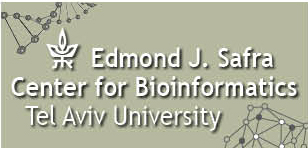In citing the ConSurf server please refer to
Ashkenazy H., Abadi S., Martz E., Chay O., Mayrose I., Pupko T., and Ben-Tal N. 2016
ConSurf 2016: an improved methodology to estimate and visualize evolutionary conservation in macromolecules
Nucl. Acids Res. 2016; DOI: 10.1093/nar/gkw408; PMID: 27166375 [ABS], [PDF]Celniker G., Nimrod G., Ashkenazy H., Glaser F., Martz E., Mayrose I., Pupko T., and Ben-Tal N. 2013.
ConSurf: Using Evolutionary Data to Raise Testable Hypotheses about Protein Function
Isr. J. Chem. 2013 March 10, doi: 10.1002/ijch.201200096 [ABS], [PDF]Ashkenazy H., Erez E., Martz E., Pupko T. and Ben-Tal N. 2010
ConSurf 2010: calculating evolutionary conservation in sequence and structure of proteins and nucleic acids.
Nucl. Acids Res. 2010; DOI: 10.1093/nar/gkq399; PMID: 20478830 [ABS], [PDF]Landau M., Mayrose I., Rosenberg Y., Glaser F., Martz E., Pupko T. and Ben-Tal N. 2005.
ConSurf 2005: the projection of evolutionary conservation scores of residues on protein structures.
Nucl. Acids Res. 33:W299-W302. [ABS], [PDF]Glaser F., Pupko T., Paz I., Bell R.E., Bechor D., Martz E. and Ben-Tal N. 2003.
ConSurf: Identification of Functional Regions in Proteins by Surface-Mapping of Phylogenetic Information.
Bioinformatics 19:163-164. [ABS], [PDF]Berezin C., Glaser F., Rosenberg J., Paz I., Pupko T., Fariselli P., Casadio R. and Ben-Tal N.
ConSeq: The Identification of Functionally and Structurally Important Residues in Protein Sequences.
Bioinformatics. Vol. 20 1322-1324, 2004. [PDF]
When using the server with protein structures (ConSurf method) please also refer to:
When using the server with sequence only (ConSeq method) please also refer to:
Main References
Mayrose I., Graur D., Ben-Tal N. and Pupko T. 2004.
Comparison of site-specific rate-inference methods for protein sequences: empirical Bayesian methods are superior.
Mol. Biol. Evol. 21:1781-1791. PDFPupko T., Bell R.E., Mayrose I., Glaser F. and Ben-Tal N. 2002.
Rate4Site: an algorithmic tool for the identification of functional regions in proteins by surface mapping of evolutionary determinants within their homologues.
Bioinformatics 18 Suppl 1:S71-S77. PDFArmon A., Graur D. and Ben-Tal N. 2001.
ConSurf: An Algorithmic Tool for the Identification of Functional Regions in Proteins by Surface-Mapping of Phylogenetic Information.
J. Mol. Biol. 307:447-463. PDFMartz E. 2005.
FirstGlance in Jmol (firstglance.jmol.org)Martz E. 2002.
Protein Explorer: easy yet powerful macromolecular visualization.
Trends in Biochemical Sciences.27:107-109. (PDF available on request.)Pettersen, E.F., Goddard, T.D., Huang, C.C., Couch, G.S., Greenblatt, D.M., Meng, E.C., and Ferrin, T.E.
UCSF Chimera - A Visualization System for Exploratory Research and Analysis.
J. Comput. Chem. 25(13):1605-1612 (2004).
Piero Fariselli and Rita Casadio.
RCNPRED: prediction of the residue co-ordination numbers in proteins.
Bioinformatics, 17, 202-204, 2001. (PDF)AS Rose and PW Hildebrand.
NGL Viewer: a web application for molecular visualization.
Nucl Acids Res, (1 July 2015) 43 (W1): W576-W579 first published online April 29, 2015. doi:10.1093/nar/gkv402. (ABS), (PDF)AS Rose, AR Bradley, Y Valasatava, JM Duarte, A Prlić and PW Rose.
Web-based molecular graphics for large complexes.
ACM Proceedings of the 21st International Conference on Web3D Technology (Web3D '16): 185-186, 2016. doi:10.1145/2945292.2945324 (ABS)
Sali A., and Blundell T.L.
Comparative protein modelling by satisfaction of spatial restraints.
J. Mol. Biol. 234:779-815, 1993 (ABS)Meier A., and Söding J.
Automatic prediction of protein 3D structures by probabilistic multi-template homology modeling.
PLoS Comput. Biol. 11:e1004343; 2015 (ABS)
Lorenz R., Bernhart S.H., Höner Zu Siederdissen C., Tafer H., Flamm C., Stadler P.F., and Hofacker I.L.
ViennaRNA Package 2.0.
Algorithms Mol. Biol. 6:26. 2011. (ABS)
Acknowledgements:
We are grateful to the Bioinformatics Unit, the Life-Science IT Unit and the George S. Wise Faculty of Life Sciences at Tel Aviv University for providing technical assistance and computation facilities.
The development was funded in part by Edmond J. Safra Center for Bioinformatics
 at Tel-Aviv university.
at Tel-Aviv university.
Development of Protein Explorer was supported by a grant to Eric Martz from the US National Science Foundation, Division of Undergraduate Education.
UCSF Chimera is developed by the Resource for Biocomputing, Visualization, and Informatics at the University of California, San Francisco (supported by NIH P41 RR-01081).